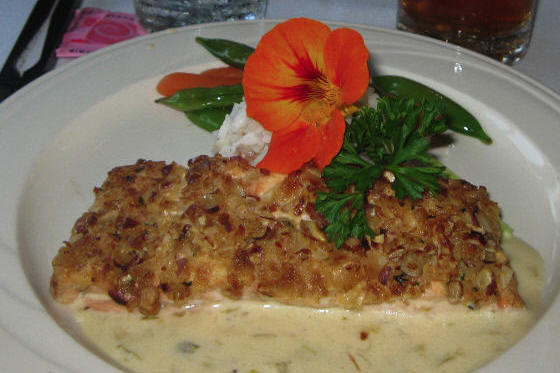 In the autumn of 2011, my husband and I vacationed in New Hampshire and Maine. One of the highlights of our trip was an excursion on
the Café Lafayette Dinner Train. The train traveled through the White Mountains in New Hampshire. We were treated to a wonderful meal on the train. Our first experience with edible flowers occurred when we were served the
salad. The salad was attractively displayed with a delicate blend of marigold petals. The marigold petals added a splash of color and taste to the salad. . We were encouraged to eat the flowers because the Café Lafayette
Dinner Train staff grew the flowers that were used in the culinary artistry that was presented. For the entrée, I chose Salmon crusted with pecans. When the entrée was served by the white-gloved waiter, the salmon was
garnished with an orange nasturtium for a touch of elegance.
In the autumn of 2011, my husband and I vacationed in New Hampshire and Maine. One of the highlights of our trip was an excursion on
the Café Lafayette Dinner Train. The train traveled through the White Mountains in New Hampshire. We were treated to a wonderful meal on the train. Our first experience with edible flowers occurred when we were served the
salad. The salad was attractively displayed with a delicate blend of marigold petals. The marigold petals added a splash of color and taste to the salad. . We were encouraged to eat the flowers because the Café Lafayette
Dinner Train staff grew the flowers that were used in the culinary artistry that was presented. For the entrée, I chose Salmon crusted with pecans. When the entrée was served by the white-gloved waiter, the salmon was
garnished with an orange nasturtium for a touch of elegance.
We enjoyed the fine dining with edible flowers so much that I decided to research edible flowers so that I could treat family and friends to meals garnished with delectable flowers.
Flower cookery has been traced back to Roman times. Edible flowers were especially popular in the Victorian era during Queen Victoria’s reign.
The secret to success when using edible flowers is to keep the dish simple, and do not add too many other flavors that will overpower the delicate taste of the flower.

One very important thing that you need to remember is that not every flower is edible. In fact, some flowers can make you very sick. Also, do not eat flowers from florists, nurseries, roadside
markets, or garden centers. In many cases, these flowers have been treated with pesticides not labeled for food crops.
For most flowers listed as being edible, they are referring to the petals only. Remove the pistils and stamens before eating as well as any attached sepals. Some flower petals you might enjoy are
Hibiscus (Hibiscus rosa-sinensis), which has a cranberry-like flavor; Impatiens (Impatiens wallerana), which has a sweet flavor; Johnny-Jump-Ups (Viola tricolor), which has a mild wintergreen flavor; Marigold (Tagetes
tenufolia), which has a citrus flavor; and Nasturtiums (Tropaeolum majus), which has a sweet, spicy flavor. Rose petals can be eaten also. The flavor depends on the type, color, and soil conditions. The flavor of roses is
more pronounced in the darker varieties.
Pick your edible flowers in the morning when their water content is the highest. Shake each flower to dislodge insects hidden in the petal folds. After removing the stamen and pistil, wash the flowers
under a fine jet of water or in a strainer placed in a large bowl of water. Drain and allow the flowers to dry on absorbent paper. The flowers will retain their odor and color provided that they dry quickly and that they are
not exposed to direct sunlight.
Remember that not all flowers are edible. It is very important that you know the history of the flowers you eat to avoid accidental poisoning. Never eat a flower that has been treated with a
pesticide.
A word of caution when dining out is to make absolutely sure that the flowers served on a plate are edible. Just because a flower is used as a garnish, doesn’t mean it is edible.
This winter as you are looking at catalogues and preparing for spring planting, be sure to include some edible flowers in your flower design plans.
Bon Appétit!
Read other articles on Herbs, Vegetables and Fruits
Read other articles by Carolyn Black